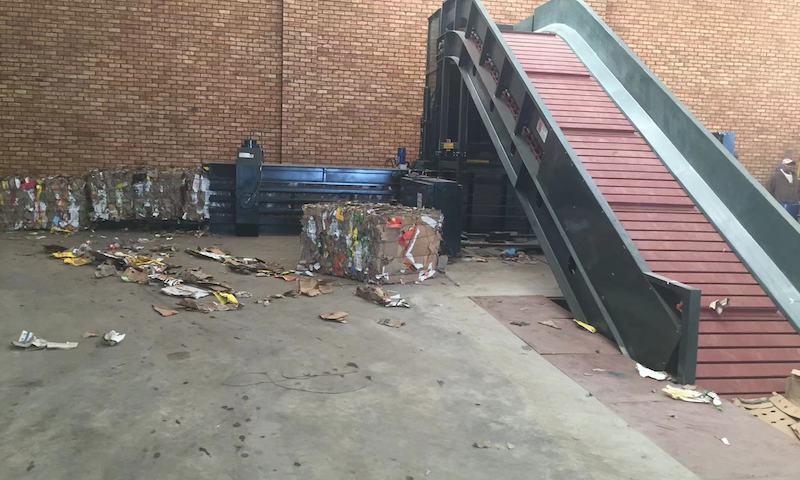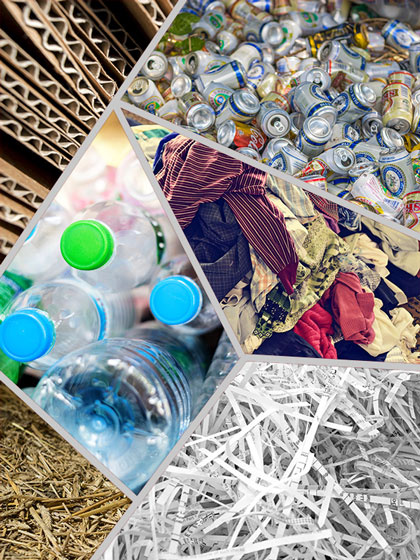
Conveyor is a most commonly used feeding method for horizontal balers. Using conveyor belts for material feeding can reduce labor and improves efficiency. There are some different types of conveyor belts in the industry. Choosing the right conveyor belt matching your baler is very vital for reaching the most efficient work and productivity. In this article, we will introduce four types of conveyors that used mostly with balers in recycling industry.
1. PVC Conveyor belt
PVC conveyor belt is mainly made of PVC (polyvinyl chloride) and polyester or blended fabric, with composite coating and scraping process. The main material is PVC. It can be directly hot melting processed. PVC conveyor belt has a wide range of applications.
When working as feeder for hydraulic baling machines, it can be used together with bagging balers / compression baggers, and sometimes closed-door manual-tie horizontal balers as well.
Advantages:
- Light-duty conveyor belt.
- Wide application range and mostly used in light industrial production.
- Economical. Lower cost than other conveyor type.
- Easy to use and convey.
- Resistive to alkaline and acids. Chemically stable to use under harsh chemical sites.
Disadvantages:
- Low hardness. Easier to wear compared with other conveyor type.
- Low resistance to oil.
2. Rubber Conveyor belt
Rubber belt is mainly made of rubber and nylon cloth or cotton canvas, which are vulcanized together. The main material is rubber. It is a material handling method widely used in industrial applications, especially in those occasions where a large number of materials need to be transported or transferred.
When working with hydraulic baling machines in recycling industry, it can be used together with horizontal balers including Closed-End Manual-tie Horizontal Balers and Auto-tie Horizontal Balers for feeding waste materials, and can handle heavy duty loads.
Advantages:
- Suits for heavy-duty activities
- Durable
- Low noise
- Impact resistance. Have buffering effect to commodities conveyed.
- Rubber belt light weight itself can improve the efficiency of transportation
Disadvantages:
- The rubber conveyor belt will wear and even damaged after certain period of time, especially when conveying heavier and more abrasive products.
3. Steel Chain Plate Conveyor belt
Steel chain plate conveyor belt is the most stable and durable conveyor type in recycling industry. The belt is made of steel plates mounted on roller chains, which enables you to handle heavy duty loads and can be used in large operations and harsh conditions. Steel plate belt has the longest lifespan compared to other conveyor belts.
When working with recycling balers, it is mainly for feeding waste materials into horizontal balers including Closed-End Manual-Tie Horizontal Balers and Auto-tie Horizontal Balers.
According to the installation way of the steel chain plate conveyor, it can be two types. One type is that the horizontal section of the conveyor is installed above ground, and the other type is that the horizontal section is installed underground (in a pit). The pit type is more popular and widely used with recyclers for its conveniency and efficiency for material loading.
Advantages:
- For heavy-duty loads.
- Stable transportation.
- Larger conveying surface than other conveyor belts.
- Most durable and long lifespan.
Disadvantage:
- Steel chain plate conveyor is more expensive than other conveyor belts.
4. Screw Conveyor (Augers):
Screw conveyor is a kind of machine that uses the motor to drive the screw to rotate and push the material to achieve the purpose of conveying. It can transport horizontally, slant or vertically.
They are simple structure, stable transport, good sealing, no noise, and low requirements for the working conditions of the site, can work in the high pollution, high corrosion, and high dust areas.
When working as feeder for hydraulic baling machines, it can be used with compression baggers / bagging balers to load dusty material of small pieces or granular materials to reduce dust flying in the factory.
Advantages:
- Sealed transmission. Suitable for conveying easy-flying and strong smell materials. Avoid the dust flying around when the material is transported. Reduce pollution to the environment. Also makes your cleaning work easy afterward.
- Suitable for short distance conveying and can accommodate in the limited working space.
- Simple structure, stable transport, and easy maintenance.
- Compact size, small section size, and small footprint.
- Long service life.
Disadvantages:
- Not suitable for long-distance conveying, as the material is easy to grind and wear in the conveying process, damage the integrity of the material itself.
- Limited conveying material. Mainly used for conveying small granular and powdery materials. Not suitable for conveying metamorphic material, and materials that are easy to stick, easy to be caking, and materials that with high water content.
A conveyor belt makes your recycling work easier. It saves you from hiring extra workforce to handle heavy tasks. While a right conveyor belt for your baler machine is vital for the smooth operation and most productivity.
